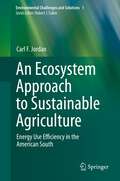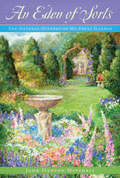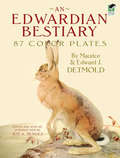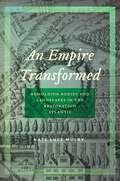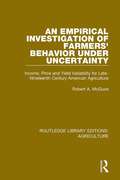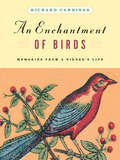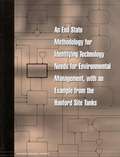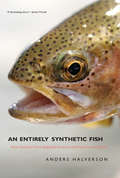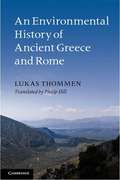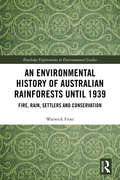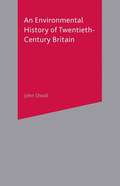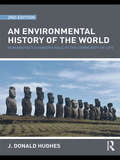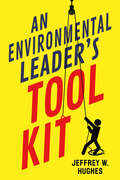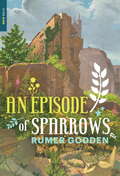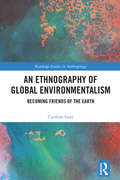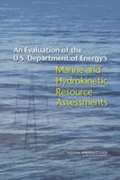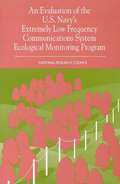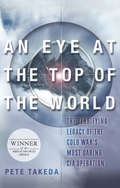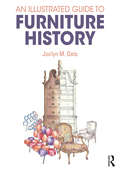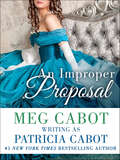- Table View
- List View
An Ecosystem Approach to Sustainable Agriculture: Energy Use Efficiency in the American South (Environmental Challenges and Solutions #1)
by Carl F. JordanModern industrial agriculture is not sustainable because of its heavy reliance on petroleum, a non-renewable source of the energy used in farming, and because of pollution caused by petroleum products such as fertilizers and pesticides. A systems analysis of farming suggests that agriculture will be more sustainable when services of nature, such as nutrient recycling by soil micro-organisms and natural controls of insects, replace the services now provided by energy from petroleum. Examples are drawn from the Southeastern USA, but lessons learned can be applied worldwide.
An Eden of Sorts: The Natural History of My Feral Garden
by John Hanson MitchellTwenty-five years ago John Hanson Mitchell cut down a 1 1/2-acre stand of seventy-five-year-old white pines and planted a garden in their place. An Eden of Sorts is a history of the plants and animals that lived on the tract over the next decades. In a survey he made before taking down the pines, Mitchell counted no more than five or six flowering plants and shrubs. Over the years he created a series of fanciful garden "rooms" in the Italian style. Now, in addition to an intriguing garden of earthly delights, he has recorded more than one thousand species of plants and animals on the property. This is a paradoxical yet hopeful narrative of what can happen to a plot of land when it is properly managed.
An Edible Alphabet
by Bonnie ChristensenEach page shows a letter of the alphabet in capital and small, a picture with the name of a plant, and pictures showing how the plant is used. A multi-cultural, multi-generational cast of characters makes this an unusual alphabet.
An Edwardian Bestiary: 87 Color Plates
by Jeff A. Menges Maurice Detmold Edward J. DetmoldA prodigiously talented pair of English twins, the Detmold brothers shared an intense passion for drawing and observing animals. As young children, they began sketching at the Zoological Gardens in London, displayed their work at the Royal Academy by the time they were 13, and published their first book of illustrations soon after. The British art world recognized their unique gift immediately and saw them as a single creative soul residing in two bodies. Their exquisite etchings, watercolors, and pen and ink drawings, rendered in the Japanese style, are remarkable for their fine detail and vivid coloration.This glorious collection of illustrations ranges from the Detmolds' 1899 debut, Pictures from Birdland, to a 1925 edition of the exotic Arabian Nights. Other selections include curious creatures great and small from Aesop's Fables and Fabre's Book of Insects. You'll encounter a meticulously rendered menagerie that includes a slithering python and fierce tiger from The Jungle Book, a vain jackdaw with beautiful plumage, a glistening lizard and butterfly in a garden, a lace-winged praying mantis, and so much more. Collectors of fine art and beautiful books, as well as animal lovers, will treasure this distinctive art from the Golden Age of book illustration.
An Empire Transformed: Remolding Bodies and Landscapes in the Restoration Atlantic (Early American Places #18)
by Kate Luce MulryExamines the efforts to bring political order to the English empire through projects of environmental improvementWhen Charles II ascended the English throne in 1660 after two decades of civil war, he was confronted with domestic disarray and a sprawling empire in chaos. His government sought to assert control and affirm the King’s sovereignty by touting his stewardship of both England’s land and the improvement of his subjects’ health. By initiating ambitious projects of environmental engineering, including fen and marshland drainage, forest rehabilitation, urban reconstruction, and garden transplantation schemes, agents of the English Restoration government aimed to transform both places and people in service of establishing order. Merchants, colonial officials, and members of the Royal Society encouraged royal intervention in places deemed unhealthy, unproductive, or poorly managed. Their multiple schemes reflected an enduring belief in the complex relationships between the health of individual bodies, personal and communal character, and the landscapes they inhabited.In this deeply researched work, Kate Mulry highlights a period of innovation during which officials reassessed the purpose of colonies, weighed their benefits and drawbacks, and engineered and instituted a range of activities in relation to subjects’ bodies and material environments. These wide-ranging actions offer insights about how restoration officials envisioned authority within a changing English empire.An Empire Transformed is an interdisciplinary work addressing a series of interlocking issues concerning ideas about the environment, governance, and public health in the early modern English Atlantic empire.
An Empirical Investigation of Farmers Behavior Under Uncertainty: Income, Price and Yield Variability for Late-Nineteenth Century American Agriculture (Routledge Library Editions: Agriculture #12)
by Robert A. McGuireThis study, first published in 1985, aims to provide objective measures of the risks associated with various crops and livestock in the late nineteenth century and to examine two important issues in American economic history. Knowledge of these risks if a necessity to the profession, if analyses of the uncertainties of postbellum agriculture are to continue. Without this knowledge, assertions which have little or no empirical content will continue to be made. This title will be of great interest to students of economics and agriculture.
An Enchantment of Birds
by Richard CanningsIn these delightful meditations, biologist and bird lover Richard Cannings weaves stories of his personal encounters with birds into fascinating descriptions of their behavior, anatomy, and evolution. He muses over the meadowlarks' ability to hide their nests so completely that he has seen only two in a lifetime spent searching for them; the trumpeter swan, as picky as a two-year old, devouring potatoes and carrots but turning up its beak at Brussels sprouts; the northern gannet, with its snowy plumage, black wingtips, and startling blue eyes; the little saw-whet owl, which dabbles in bigamy and even trigamy; and more than two dozen other birds. Covering the entire continent, from the cacophony of a seabird colony on the shores of the Atlantic to a symphony of snow geese on the autumn plains to songbird courtship in the alpine tundra of the Rockies, An Enchantment of Birds informs and entertains, in one fell swoop.
An End State Methodology for Identifying Technology Needs for Environmental Management, with an Example from the Hanford Site Tanks
by Committee on Technologies for Cleanup of High-Level Waste in Tanks in the DOE Weapons ComplexThe National Academies Press (NAP)--publisher for the National Academies--publishes more than 200 books a year offering the most authoritative views, definitive information, and groundbreaking recommendations on a wide range of topics in science, engineering, and health. Our books are unique in that they are authored by the nation's leading experts in every scientific field.
An Entirely Synthetic Fish
by Anders HalversonAnders Halverson provides an exhaustively researched and grippingly rendered account of the rainbow trout and why it has become the most commonly stocked and controversial freshwater fish in the United States. Discovered in the remote waters of northern California, rainbow trout have been artificially propagated and distributed for more than 130 years by government officials eager to present Americans with an opportunity to get back to nature by going fishing. Proudly dubbed "an entirely synthetic fish" by fisheries managers, the rainbow trout has been introduced into every state and province in the United States and Canada and to every continent except Antarctica, often with devastating effects on the native fauna. Halverson examines the paradoxes and reveals a range of characters, from nineteenth-century boosters who believed rainbows could be the saviors of democracy to twenty-first-century biologists who now seek to eradicate them from waters around the globe. Ultimately, the story of the rainbow trout is the story of our relationship with the natural world--how it has changed and how it startlingly has not.
An Environmental History of Ancient Greece and Rome
by Lukas Thommen Philip HillIn ancient Greece and Rome an ambiguous relationship developed between man and nature, and this decisively determined the manner in which they treated the environment. On the one hand, nature was conceived as a space characterized and inhabited by divine powers, which deserved appropriate respect. On the other, a rationalist view emerged, according to which humans were to subdue nature using their technologies and to dispose of its resources. This book systematically describes the ways in which the Greeks and Romans intervened in the environment and thus traces the history of the tension between the exploitation of resources and the protection of nature, from early Greece to the period of late antiquity. At the same time it analyses the comprehensive opening up of the Mediterranean and the northern frontier regions, both for settlement and for economic activity. The book's level and approach make it highly accessible to students and non-specialists.
An Environmental History of Australian Rainforests until 1939: Fire, Rain, Settlers and Conservation (Routledge Explorations in Environmental Studies)
by Warwick FrostThis book provides a comprehensive environmental history of how Australia’s rainforests developed, the influence of Aborigines and pioneers, farmers and loggers, and of efforts to protect rainforests, to help us better understand current issues and debates surrounding their conservation and use. While interest in rainforests and the movement for their conservation are often mistakenly portrayed as features of the last few decades, the debate over human usage of rainforests stretches well back into the nineteenth century. In the modern world, rainforests are generally considered the most attractive of the ecosystems, being seen as lush, vibrant, immense, mysterious, spiritual and romantic. Rainforests hold a special place; both providing a direct link to Gondwanaland and the dinosaurs and today being the home of endangered species and highly rich in biodiversity. They are also a critical part of Australia’s heritage. Indeed, large areas of Australian rainforests are now covered by World Heritage Listing. However, they also represent a dissonant heritage. What exactly constitutes rainforest, how it should be managed and used, and how much should be protected are all issues which remain hotly contested. Debates around rainforests are particularly dominated by the contradiction of competing views and uses – seeing rainforests either as untapped resources for agriculture and forestry versus valuing and preserving them as attractive and sublime natural wonders. Australia fits into this global story as a prime example but is also of interest for its aspects that are exceptional, including the intensity of clearing at certain periods and for its place in the early development of national parks. This book will be of great interest to students and scholars of Environmental History, Australian History and Comparative History.
An Environmental History of Latin America
by Shawn William MillerThis book narrates the mutually mortal historical contest between humans and nature in Latin America. Covering a period that begins with Amerindian civilizations and concludes in the region's present urban agglomerations, the work offers an original synthesis of the current scholarship on Latin America's environmental history and argues that tropical nature played a central role in shaping the region's historical development. Seeing Latin America's environmental past from the perspective of many centuries illustrates that human civilizations, ancient and modern, have been simultaneously more powerful and more vulnerable than previously thought.
An Environmental History of Russia
by Paul Josephson Nicolai Dronin Aleh Cherp Ruben Mnatsakanian Dmitry Efremenko Vladislav LarinThe former Soviet empire spanned eleven time zones and contained half the world's forests; vast deposits of oil, gas and coal; various ores; major rivers such as the Volga, Don and Angara; and extensive biodiversity. These resources and animals, as well as the people who lived in the former Soviet Union – Slavs, Armenians, Georgians, Azeris, Kazakhs and Tajiks, indigenous Nenets and Chukchi – were threatened by environmental degradation and extensive pollution. This environmental history of the former Soviet Union explores the impact that state economic development programs had on the environment. The authors consider the impact of Bolshevik ideology on the establishment of an extensive system of nature preserves, the effect of Stalinist practices of industrialization and collectivization on nature, and the rise of public involvement under Khrushchev and Brezhnev, and changes to policies and practices with the rise of Gorbachev and the break-up of the USSR.
An Environmental History of Twentieth-Century Britain
by John SheailEnvironmental history - the history of the relationship between people and the natural world - is a dynamic and increasingly important field. In An Environmental History of Twentieth-Century Britain, John Sheail breaks new ground in illustrating how some of the most pressing concerns came to be recognised, and a response made. Much use is made of archival sources in tracing a number of key issues, including: * management of change by central and local government * the manner in which natural processes were incorporated in projects to protect personal and public health, and ultimately environmental health * new beginnings in forestry * the emergence of a third force alongside farming and forestry in the countryside * management of a transport revolution, and mitigation of environmental hazards Such instances of policy-making are reviewed within the wider context of a growing awareness, both on the part of government and business, of the role of environmental issues in the creation of wealth and social well-being for us all. An Environmental History of Twentieth-Century Britain is essential reading for all those concerned with these issues.
An Environmental History of the World: Humankind's Changing Role in the Community of Life
by J. Donal Hughes J. Donald HughesThis second edition of An Environmental History of the World continues to present a concise history, from ancient to modern times, of the interactions between human societies and the natural environment, including the other forms of life that inhabit our planet. Throughout their evolutionary history, humans have affected the natural environment, sometimes with a promise of sustainable balance, but also in a destructive manner. This book investigates the ways in which environmental changes, often the result of human actions, have caused historical trends in human societies. This process has happened in every historical period and in every part of the inhabited earth. The book is organized into ten chapters. The main chapters follow a chronological path through the history of mankind, in relationship to ecosystems around the world. The first explains what environmental history is, and argues for its importance in understanding the present state of the world's ecological problems. Chapters two through eight form the core of the historical analysis, each concentrating on a major period of human history (pre-civilized, early civilizations, classical, medieval, early modern, early and later twentieth century, and contemporary) that has been characterized by large-scale changes in the relationship between human societies and the biosphere, and each gives several case studies that illustrate significant patterns occurring at that time. The chapters covering contemporary times discuss the physical impacts of the huge growth in population and technology, and the human responses to these problems. Our moral obligations to nature and how we can achieve a sustainable balance between technology and the environment are also considered. This revised second edition takes account of new research and the course of history containing new sections on global warming, the response of New Orleans to the hurricanes Katrina and Rita, and the experience of the Dutch people in protecting their low-lying lands against the encroachments of rivers, lakes, and the North Sea. New material is also offered on the Pacific Islands, including the famous case of Easter Island. This is an original work that reaches further than other environmental histories. Rather than looking at humans and the environment as separate entities, this book places humans within the community of life. The relationship between environmental thought and actions, and their evolution, is discussed throughout. Little environmental or historical knowledge is assumed from the reader in this introduction to environmental history. We cannot reach a useful understanding of modern environmental problems without the aid of perspective provided by environmental history, with its illustrations of the ways in which past decisions helped or hindered the interaction between nature and culture. This book will be influential and timely to all interested in or researching the world in which we live.
An Environmental History of the World: Humankind's Changing Role in the Community of Life (Routledge Studies In Physical Geography And Environment Ser. #Vol. 2)
by J. Donald HughesThis second edition of An Environmental History of the World continues to present a concise history, from ancient to modern times, of the interactions between human societies and the natural environment, including the other forms of life that inhabit our planet. Throughout their evolutionary history, humans have affected the natural environment, sometimes with a promise of sustainable balance, but also in a destructive manner. This book investigates the ways in which environmental changes, often the result of human actions, have caused historical trends in human societies. This process has happened in every historical period and in every part of the inhabited earth. The book is organized into ten chapters. The main chapters follow a chronological path through the history of mankind, in relationship to ecosystems around the world. The first explains what environmental history is, and argues for its importance in understanding the present state of the world's ecological problems. Chapters two through eight form the core of the historical analysis, each concentrating on a major period of human history (pre-civilized, early civilizations, classical, medieval, early modern, early and later twentieth century, and contemporary) that has been characterized by large-scale changes in the relationship between human societies and the biosphere, and each gives several case studies that illustrate significant patterns occurring at that time. The chapters covering contemporary times discuss the physical impacts of the huge growth in population and technology, and the human responses to these problems. Our moral obligations to nature and how we can achieve a sustainable balance between technology and the environment are also considered. This revised second edition takes account of new research and the course of history containing new sections on global warming, the response of New Orleans to the hurricanes Katrina and Rita, and the experience of the Dutch people in protecting their low-lying lands against the encroachments of rivers, lakes, and the North Sea. New material is also offered on the Pacific Islands, including the famous case of Easter Island. This is an original work that reaches further than other environmental histories. Rather than looking at humans and the environment as separate entities, this book places humans within the community of life. The relationship between environmental thought and actions, and their evolution, is discussed throughout. Little environmental or historical knowledge is assumed from the reader in this introduction to environmental history. We cannot reach a useful understanding of modern environmental problems without the aid of perspective provided by environmental history, with its illustrations of the ways in which past decisions helped or hindered the interaction between nature and culture. This book will be influential and timely to all interested in or researching the world in which we live.
An Environmental Leader's Tool Kit
by Jeffrey W. HughesIf you want to tackle an environmental problem in your neighborhood but do not know where to start, An Environmental Leader's Tool Kit can help. In this handbook, Jeffrey W. Hughes shares the proven strategies you need to step up and get meaningful action done.From designing a pilot study to managing contentious public meetings and more, Hughes walks you through the essentials of effective place-based environmental efforts. Among the tools you will find here are worksheets to kickstart brainstorming, appendixes that demystify jargon you might encounter, and illuminating, real-life examples. Down-to-earth and stimulating, An Environmental Leader's Tool Kit is a launchpad for those ready to make a difference now.
An Episode of Sparrows
by Rumer GoddenA much-loved English novel reminiscent of "The Secret Garden" Someone has dug up the private garden in the square and taken buckets of dirt, and Miss Angela Chesney of the Garden Committee is sure that a gang of boys from run-down Catford Street must be to blame. But Angela's sister Olivia isn't so sure. Olivia wonders why the neighborhood children--the "sparrows" she sometimes watches from the window of her house --have to be locked out of the garden. Don't they have a right to enjoy the place, too? But neither Angela nor Olivia has any idea what sent the neighborhood waif Lovejoy Mason and her few friends in search of "good, garden earth. " Still less do they imagine where their investigation of the incident will lead them--to a struggling restaurant, a bombed-out church, and at the heart of it all, a hidden garden.
An Ethnography of Global Environmentalism: Becoming Friends of the Earth (Routledge Studies in Anthropology)
by Caroline GattBased on nine years of research, this is the first book to offer an in-depth ethnographic study of a transnational environmentalist federation and of activists themselves. The book presents an account of the daily life and the ethical strivings of environmental activist members of Friends of the Earth International (FoEI), exploring how a transnational federation is constituted and maintained, and how different people strive to work together in their hope of contributing to the creation of "a better future for the globe." In the context of FoEI, a great diversity of environmentalisms from around the world are negotiated, discussed and evolve in relation to the experiences of the different cultures, ecosystems and human situations that the activists bring with them to the federation. Key to the global scope of this project is the analysis of FoEI experiments in models for intercultural and inclusive decision-making. The provisional results of FoEI’s ongoing experiments in this area offer a glimpse of how different notions of the environment, and being an environmentalist, can come to work together without subsuming alterity.
An Evaluation of Japanese Environmental Regulations: Quantitative Approaches from Environmental Economics
by Toshi H. Arimura Kazuyuki IwataFocusing on air pollution, energy efficiency and climate change, this book provides an introduction to Japan's environmental policies and regulations, and offers economic analyses and RIAs (Regulatory Impact Analysis) of environmental regulations implemented or planned by the national and local governments. The opening chapter reviews environmental economics and outlines the current status of RIAs in Japan. Chapter 2 analyzes the NOx-PM Act, which prohibits the use of old and polluting vehicles in metropolitan areas. Chapter 3 examines a Tokyo metropolitan government regulation which requires installation of pollution control equipment in older trucks that fail to meet emission standards. Chapter 4 traces the impact of the NOx-PM Act on the used car market and used vehicle exports. Chapter 5 presents an economic analysis of a highway toll reduction, revealing an unexpected negative social impact: it increased traffic congestion and associated environmental problems. The final three chapters address policies and regulations related to energy efficiency and climate change Chapter 6 evaluates the effectiveness of Japan's Energy Conservation Act, originally introduced in 1979 and amended numerous times to address climate change. Chapter 7 anticipates the impact of a proposed economy-wide carbon tax, using input-output analysis to assess short-term economic impacts in each sector. Also presented here is an examination of the effectiveness of a reduced carbon tax for energy-intensive industries, with a discussion of the impact of the proposal on households. The final chapter discusses the role and limitations of economic models for evaluating Japan's mid-term GHG (Greenhouse Gas) emission target during the post-Kyoto period. This is the first book to evaluate Japanese environmental policies from an economic perspective, using a variety of current quantitative approaches. Its findings and suggestions will benefit students, policy makers and government officials in developing and developed countries where the public faces similar environmental problems.
An Evaluation of the U.S. Department of Energy’s Marine and Hydrokinetic Resource Assessments
by Marine Hydrokinetic Energy Technology Assessment CommitteeIncreasing renewable energy development, both within the United States and abroad, has rekindled interest in the potential for marine and hydrokinetic (MHK) resources to contribute to electricity generation. These resources derive from ocean tides, waves, and currents; temperature gradients in the ocean; and free-flowing rivers and streams. One measure of the interest in the possible use of these resources for electricity generation is the increasing number of permits that have been filed with the Federal Energy Regulatory Commission (FERC). As of December 2012, FERC had issued 4 licenses and 84 preliminary permits, up from virtually zero a decade ago. However, most of these permits are for developments along the Mississippi River, and the actual benefit realized from all MHK resources is extremely small. The first U. S. commercial gridconnected project, a tidal project in Maine with a capacity of less than 1 megawatt (MW), is currently delivering a fraction of that power to the grid and is due to be fully installed in 2013. As part of its assessment of MHK resources, DOE asked the National Research Council (NRC) to provide detailed evaluations. In response, the NRC formed the Committee on Marine Hydrokinetic Energy Technology Assessment. As directed in its statement of task (SOT), the committee first developed an interim report, released in June 2011, which focused on the wave and tidal resource assessments (Appendix B). The current report contains the committee's evaluation of all five of the DOE resource categories as well as the committee's comments on the overall MHK resource assessment process. This summary focuses on the committee's overarching findings and conclusions regarding a conceptual framework for developing the resource assessments, the aggregation of results into a single number, and the consistency across and coordination between the individual resource assessments. Critiques of the individual resource assessment, further discussion of the practical MHK resource base, and overarching conclusions and recommendations are explained in An Evaluation of the U. S. Department of Energy's Marine and Hydrokinetic Resource Assessment.
An Evaluation of the U.S. Navy's Extremely Low Frequency Communications System Ecological Monitoring Program
by Committee to Evaluate the U.S. Navy's Extremely Low Frequency Communications System Ecological Monitoring ProgramThe U.S. Navy established an ecological monitoring program to determine whether electric and magnetic fields from extremely low frequency (ELF) communications systems influenced plant and animal populations near the transmitting facilities. Although some of the researchers believe that a few biological changes might have occurred, they concluded that the results do not indicate significant adverse ecological effects.This book evaluates the 11 ecological studies of the Navy's monitoring program and examines the adequacy of experimental design, the data collection and analysis, and the soundness of the conclusions. It also addresses whether the monitoring program was capable of detecting subtle effects due to ELF exposure and examines the biological changes observed by some program researchers, such as enhanced tree growth.
An Eye at the Top of the World: The Terrifying Legacy of the Cold War's Most Daring CIA Operation
by Pete TakedaAt some point during the inhumanly cold Himalayan winter straddling 1965 and 1966, a peculiar collection of box-shaped objects -- one sprouting a six-foot, insect-like antenna -- plummets nine thousand feet down the sheer flanks of a remote peak. Ripped from its moorings by an avalanche, the jumbled apparatus slides down a funnel-shaped hourglass of hard snow and shoots over a black cliff band, careening a vertical distance six times the height of the Empire State building. The boxes come to rest on the glacier at the mountain's base. One, an olive-drab casing the size of a personal computer, begins to sink. Then, trailing a robotic dogtail of torn wires, it slowly burns through the snow, melting into solid blue glacial ice, eventually disappearing beneath the surface, and never seen again. No one actually witnessed this event. But as you read these words, nearly four pounds of plutonium -- locked in the glacier's dark unknowable heart -- are almost certainly moving ever closer to the source of the Ganges River. Eye at the Top of the World, provides a harrowing present-day account of Takeda's expedition to solve the mystery of Nanda Devi.
An Illustrated Guide to Furniture History
by Joclyn M. OatsAn Illustrated Guide to Furniture History provides upper-level students and instructors with an alternative visual analytical approach to learning about furniture history from Antiquity to Postmodernism. Following an immersive teaching model, it presents a Nine-Step Methodology to help students strengthen their visual literacy and quickly acquire subject area knowledge. Moving chronologically through key periods in furniture history and interior design, such as the Renaissance, the Arts and Crafts Movement, and Modernism, it traverses Europe to America to present a comprehensive foundational guide to the history of furniture design. Part I addresses furniture within the context of the built environment, with chapters exploring the historical perspective, construction principles, and the categorization of furniture. In Part II, the author visually depicts the structural organization of the methodological process, a three-category framework: History, Aesthetics, and Visual Notes. The chapters in this part prepare the reader for the visual analysis that will occur in the final section of the book. The book is lavishly illustrated in full color with over 300 images to reinforce visual learning and notation. A must-have reference and study guide for students in industrial and product design, interior design, and architecture.
An Improper Proposal
by Meg Cabot Patricia CabotA fearless young woman scandalously pursues the captain of her heart in this adventuresome Victorian romance.England, 1830. Swashbuckling beauty Payton Dixon has two passionate dreams—to sail the open sea on her own clipper ship, and to capture the love of Captain Connor Drake. But both seem impossibly out of reach, since her beloved captain is about to marry another, and worse, he’s been given her ship as a wedding present from her traitorous father.Out to prove she has right on her side, Payton manages to unleash a scandal and ignite all sorts of trouble. As for Drake, he’s surprised to discover that the girl he’s grown up with has transformed into the most alluring woman he’s ever encountered.
